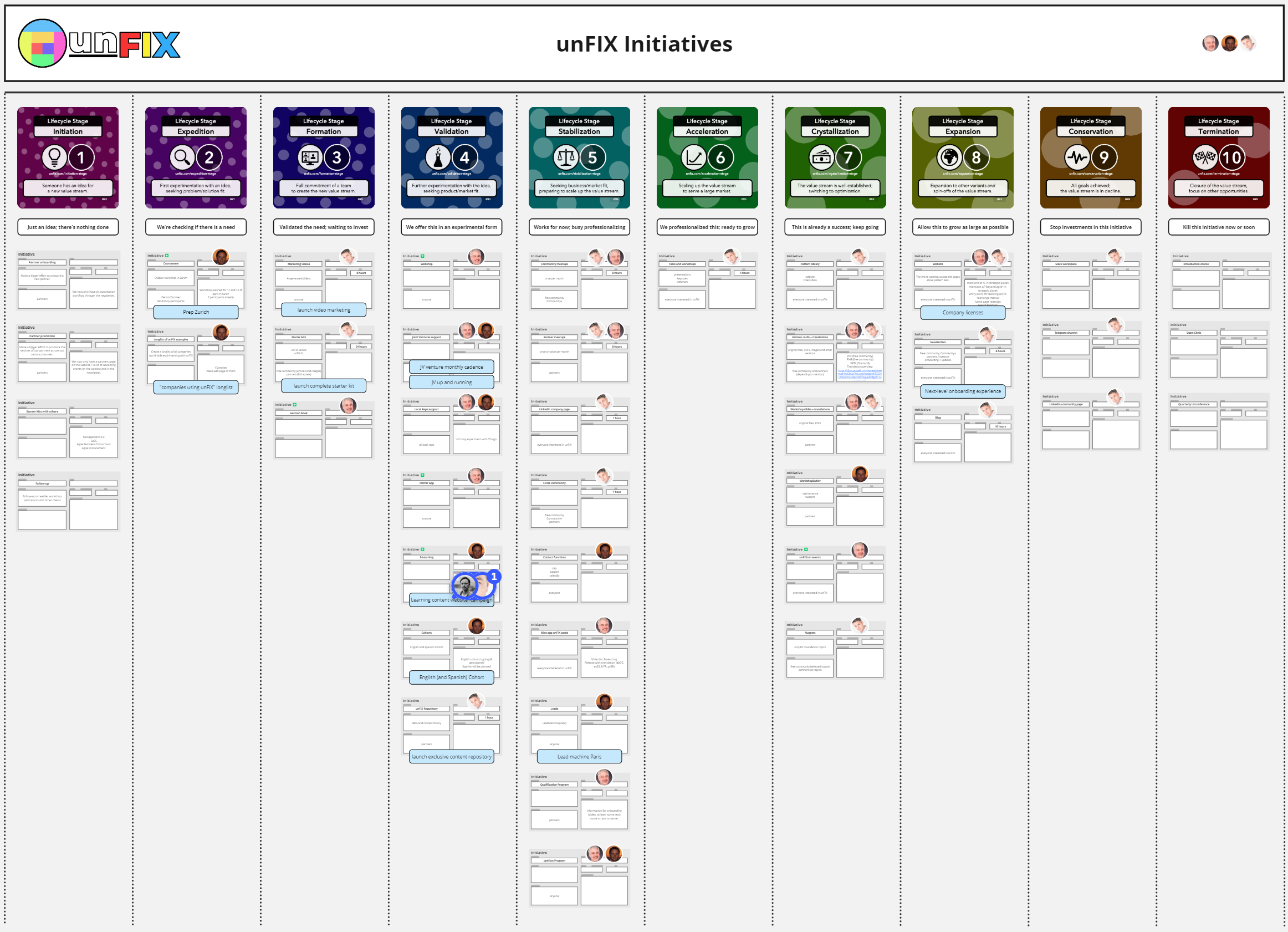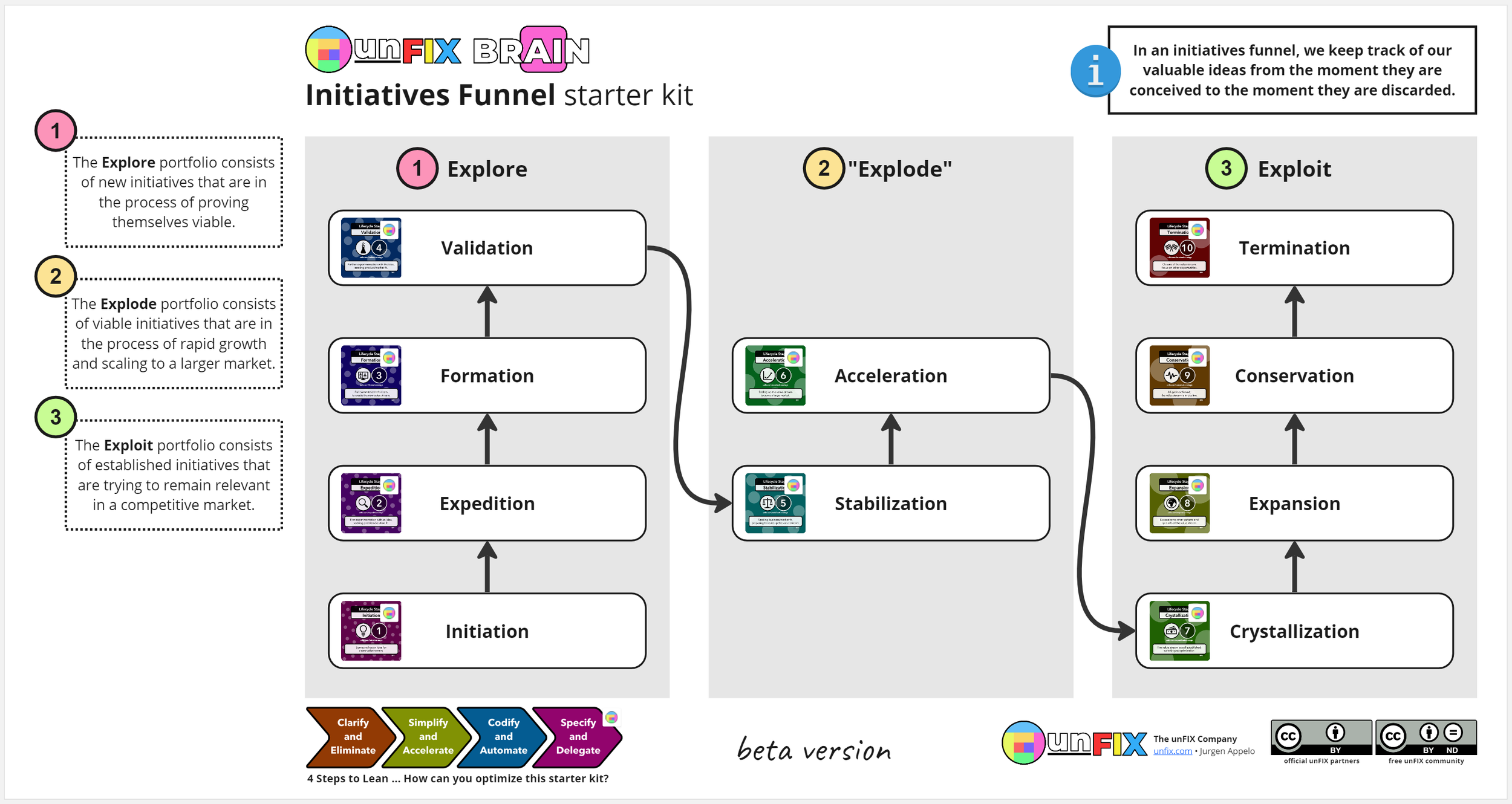You Are a Portfolio Manager (Everyone Is)
Author: Jurgen Appelo
You manage portfolios, whether you like it or not. That's because "You Build It, You Own It."
Let's stop pretending that a person or a team should "focus on only one thing." It's impossible. Nobody can do that. And even if they could, one "thing" always consists of multiple "sub-things," so you're back where you started: managing various (sub-)things.
Furthermore, as any investment manager can tell you, never put all your eggs in one basket! You should spread your risk across a portfolio of ideas. Betting the future of your product on only one thing is the riskiest thing you could do.
The Initiatives of the unFIX Team
Initiatives
In The unFIX Company, we focus on one thing: the unFIX model (and our membership/partnership business model). But that one thing consists of many sub-things: our website, cards, blog, newsletter, workshop materials, LinkedIn page, online community, qualification program, webshop, Miro app, Plotter app, E-learning modules, etc. Our Product has many Initiatives. (Some might call them "product areas.") We can not focus on only the newsletter for an entire week, nor can we work only on the website. (Can you imagine the horror of a 40-hour community meetup?) In our small-team context, focusing on one (sub-)thing is impossible. And from a risk management perspective, it would be the dumbest thing to do.
Sidenote: the experts advocating that you should “focus on one thing” always have many things going on themselves: books, workshops, conferences, coaching, consultancy, etc. It sounds like, “Do as I say, not as I do!”
It is the same for many other agile and non-agile teams. Even in the (rare) cases when they focus on one product, that product will still consist of multiple product areas (or Initiatives). For example, "Account Management," "Reporting and Analytics," "Support/Help," "Knowledge Base," "Imports and Exports," "API and Integrations," etc. Some product areas will be new (maybe only conceived last month); others will be old (perhaps even ready for retirement). Some Initiatives are successful parts of the Product; others are failures and should be killed. The fact is, these Initiatives support the product in different ways, so the product does not depend on one single thing. That would be very risky. (You can read about Initiatives here.)
Initiatives need management across lifecycle stages.
You have new, old, successful, and failed ideas. It's best to manage those ideas—in portfolios.
Portfolios of Initiatives
Exploration Portfolio
Your Exploration portfolio consists of the Initiatives (or ideas or product areas, if you prefer) that have not yet proven themselves. (Lifecycle stages 1 to 4.) They are—hopefully—part of the future value proposition of your product. For example, at the time of writing, our team has "Marketing Videos," "Starter Kits," "E-Learning," "Cohorts," and "Webshop" sitting in our Exploration portfolio. They all contribute to the same product or business model. These Initiatives are relatively new ideas that we manage as explorations.
The Explore portfolio consists of new initiatives that are in the process of proving themselves viable.
Exploitation Portfolio
Your Exploitation portfolio consists of the Initiatives (or ideas or product areas, if you want) that are validated and mature and are part of the current value proposition of the product. (Lifecycle stages 7 to 10.) For example, at the time of writing, our team has "Pattern Library," "Cards," "Workshop Materials," "Website," and "Newsletters" sitting in the Exploitation portfolio. These Initiatives have already grown into valuable parts of our product offering.
The Exploit portfolio consists of established initiatives trying to remain relevant in a competitive market.
Scaling and Reverse-Scaling
Everyone has Exploration and Exploitation portfolios, no matter the scale of the team or organization, because everyone is juggling new and old ideas, successful and failed ideas. The fact that we invest our time, money, and resources in multiple ideas means that all of us are portfolio managers.
In their book The Invincible Company, Alexander Osterwalder and his colleagues explain the essential differences between the Exploitation and Exploration portfolios. “Don't manage them in the same way,” they say! Future value is different from current value. The book offers many examples of professional business portfolios involving millions of investment dollars.
However, the size of investments shouldn't matter. Whether you manage a vast portfolio budget of 40 million dollars or just a tiny one of just 40 hours per week is irrelevant. The mathematics are the same. The decisions made by an Investment Manager dealing with twenty startups are the same as those of a Product Owner handling twenty product areas. The principles of risk management are “self-similar at scale.” You have multiple Initiatives, but you can invest each dollar (or each hour) only once. How will you spread your resources?
You do that by managing your portfolio.
The decisions made by an Investment Manager dealing with twenty startups are the same as those of a Product Owner handling twenty product areas.
The principles described in The Invincible Company apply not only to enterprises; they also apply to small teams. Only the budgets are much smaller, and the weekly/monthly practices are much simpler.
The problem is that most teams do not manage their portfolios.
Scrum
There is no concept of Initiatives (or product areas) in Scrum. Teams receive work items in the form of goals and user stories. They discuss them, work on them, deliver them, and they're done. When a goal is accomplished, the team moves on to the next.
But Initiatives don't just disappear when delivered. Once the API/Integration module is released to customers, it's still there. When you've finished building the Import/Exports module, it will need ongoing care. After deploying the Knowledge Base, somebody will have to fill and maintain it. You'll have to devise your own approach to managing these product areas because the Scrum framework offers zero guidance.
SAFe
The Scaled Agile Framework (6.0) does recognize portfolio management—however, only at a high (executive) level. There are no portfolios within ARTS and agile teams. They face the same challenge as Scrum teams: there are things they delivered earlier that will need regular attention. Granted, SAFe recognizes that teams need Capacity Management, but it offers no guidance on how teams should invest their time across different Initiatives.
A second issue is that SAFe 6.0 describes only the Exploration portfolio (at a high level). It has no equivalent of an Exploitation portfolio. When Epics "graduate" from the Exploration portfolio, they are turned into Objectives and Features. SAFe completely forgets that they were Initiatives that will need monitoring and maintenance in the future.
You Build It, You Own It
There is a famous saying in software development: "You Build It, You Own It." It means when you create something new, you should not throw it over the wall and make it somebody else's problem. The creator/developer remains responsible for maintaining and supporting the earlier Initiatives.
I've always lived by the same rule. Whether it's my websites, books, blog posts, illustrations, courseware, or videos, I remain responsible for all the Initiatives I've launched before—until I deliberately retire and kill them. After I build things, I own them.
Agile frameworks such as Scrum and SAFe offer plenty of guidance on building things, but there is practically no guidance on owning them.
"Explosion Portfolio"
What about the third portfolio, in the middle?
The "Explosion" portfolio has a tongue-in-cheek name. The reason is that we already used the words Extension and Expansion in the unFIX pattern library, and it's OK to have a bit of fun now and then. 😁
The "Explosion" portfolio consists of the Initiatives (or ideas or product areas, if you like) that are validated but not mature yet and are still expected to grow. (Lifecycle stages 5 and 6.) For example, at the time of writing, our team has "Community Meetups," "Circle Community," "Miro app," and "Qualification Program" sitting in the "Explosion" portfolio. They are the ideas that have proven to be valuable. However, our team needs more time and investment to turn them into bigger successes.
The Explode portfolio consists of viable initiatives that are in the process of rapid growth and scaling to a larger market.
Kent Beck's “3X model”
I am not the first to recognize a third phase between Exploration and Exploitation. In his “3X model”, Kent Beck called them Explore, Expand, and Extract: different words, same idea. Like me, Kent Beck recognized that the middle part ("Explode" / Expand) deserves to be treated differently. You may see that as a separate portfolio.
Conclusion
Managing your portfolio of Initiatives is essential but doesn't have to be complicated. A brief, monthly meeting where you review your list of Initiatives should be sufficient. That's what smart portfolio managers do. Regularly, they decide what to start, what to stop, and what to continue, given the available time, money, and resources. But they NEVER invest in just one thing.
If you don't manage your portfolios, you only build but never own.
Are you interested in learning to manage your Initiatives? Contact us. We are learning, too! 🙂




